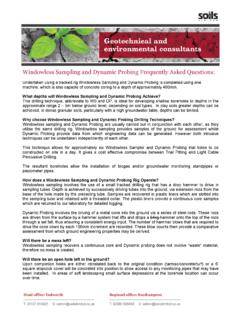Transcription of Light Cable Percussive Frequently Asked Questions
1 Light Cable Percussive Frequently Asked Questions : What depths will Light Cable Percussive drilling Achieve? This drilling technique, also known as shell and auger drilling , is ideal for developing medium to deep boreholes to depths in the approximate range 7 60m below ground level, depending on soil types. Why choose Light Cable Percussive drilling Techniques? The information achieved from this drilling technique gives soil samples in cohesive soils can be taken for laboratory testing, and testing by means of in-situ penetration tests using split a spoon sampler (SPT or 600. fixed cones SPT(C)) From this assessments of soil conditions can be undertaken. Undisturbed/disturbed sample recovery at regular intervals allows us to take samples to send to the laboratory to allow us to assess the contamination present within the ground.
2 The resultant boreholes allow the installation of biogas and/or groundwater monitoring standpipes, piezometric pipes, settlement gauges or inclinometer tubes. How does a Light Cable Percussive Drill Rig Operate? This is a drop tool type drilling method which uses steel casing tubes to prevent collapse of the borehole during drilling . The rig comprises a large tripod and winch which are used to lift and drop heavy cutting tools down onto the base of the borehole. The type of tool used depends on the type of soil present, clay cutters are used in heavy clays, bailers are used with water to remove gravels and chisels can be used to smash up hard strata at depth. Heavy hammer weights can also be added onto the tops of these cutting tools to increase the momentum of the dropping tool.
3 Will there be a mess left? This drilling technique brings samples and excess arisings to the surface, therefore a small amount of mess can be expected during works. However sensitive landscaping can be protected using ply sheets and creating a bunded tank around the hole aperture. Arisings can be bagged and removed from site or placed into a skip for disposal. Will there be an open hole left in the ground? Upon completion holes are either reinstated back to the original condition (tarmac/concrete/turf) or a 6'. square stopcock cover will be concreted into position to allow access to any monitoring pipes that may have been installed. In areas of soft landscaping small surface depressions at the borehole location can occur over time.
4 Are there access restrictions? A Light Percussive Drill Rig is towed by a four-wheel drive vehicle and is erected above the required borehole position. If site conditions require it is possible to get an adapted, low head room rig, that is capable of operating in low head room (eg. basements). General dimensions (normal rig): Height: Working area: x Level drilling area (no more that 5 ). Pros Cons Deep depth achievable Access restrictions Minimal disturbance at ground level More expensive than window sampling/trial pitting Allows installation of monitoring pipes Cannot penetrate rock Contamination assessment on Arisings require disposal recovered samples Geotechnical assessment of ground conditions Variable diameter boreholes
